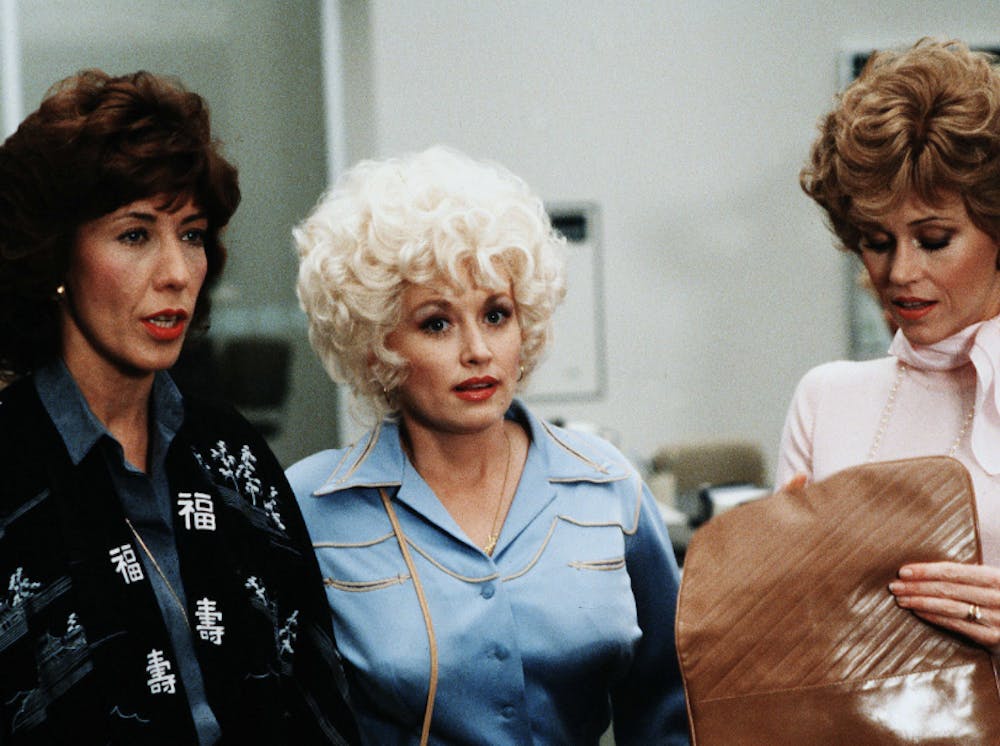I have always enjoyed films about women doing and taking what is rightfully theirs. Be it work, a title or respect, it is empowering to see female characters unafraid to take a stand. Many of these films, however, are dependent on the expectation that women need to put other women down: “Mean Girls,” for example, villianizes typically feminine traits, and even Sharpay of “High School Musical” felt like she couldn’t succeed in her theatre career without sabotaging Gabriella. Yet, in Colin Higgins’ “9 to 5,” the women in the film stand by and with each other, not out of convenience or pleasantries, but necessity.
After her husband divorces her for his secretary, Judy Bernly (Jane Fonda) starts working as a secretary for Consolidated Companies. On her first day, widowed mother and twelve-year employee Violet Newstead (Lily Tomlin) shows Judy her way around the office, which, in addition to learning about copying machines and desk rules, involves navigating the tense office politics surrounding their blatantly misogynistic boss, Mr. Hart.
Mr. Hart (Dabney Coleman) is rude from the start, but his disrespect against women becomes obvious very quickly. On her first day, for example, he says Judy is a “pretty addition” to the office. He still asks an experienced Violet to go on coffee runs and buy gifts for his wife (and if she declines out of discomfort, he condemns her for being disagreeable), and gives a promotion to a man with far less experience than Violet on the basis that “clients would rather deal with men when it comes to figures.”
As Violet storms out of his office after receiving the unjust news, Mr. Hart’s secretary Doralee Rhodes (Dolly Parton) learns that her exclusion from the other women in the office, her days of eating lunch alone, is because they think she has been having an affair with the boss — all thanks to the leering glances and unwanted advances of Mr. Hart. The three women, infuriated with their given roles as company doormats, unwind over a drink, a joint and their fantasies of getting revenge on Mr. Hart. And, through a series of coffee mistakes, hospital visits, getaway drives, chain collars and forged signatures, they certainly do.
The office satire never fails to make me laugh, from the rat poison and skinny-and-sweet mix-up to the Xerox panic similar to the “I Love Lucy” chocolate factory episode (or the “Drake and Josh” sushi conveyor belt scene, for my younger audience). Tomlin’s snarky one-liners and Parton’s threats to change Hart “from a rooster to a hen with one shot” are funny, clever and exude a confidence that embraces the power of women working together.
Released December of 1980, “9 to 5” came with a rise of women in the workplace after the women’s liberation movement of the ‘70s. Women were providing financially for their families by climbing the corporate ladder, and the women of this film are no exception: in one of my personally favorite scenes, Violet shifts between client phone calls about financial figures and her kids’ fights about favorite foods without skipping a beat.
I find it interesting, though, how after hearing that Violet has been working for the company or twelve years, Judy claims, “All I’ve done is be a housewife.” She says it with humility — as if to show how impressed she is by Violet — but also a sense of regret. A sense of sadness, almost, that may reflect the social and cultural dilemma women were facing in the early ‘80s: maybe they did not feel satisfied with staying at home (or were convinced that they shouldn’t be), but faced immense challenges when entering the workforce. By the end of the film, though, the three heroines address many of these challenges by using a captive Mr.Hart’s signature to implement long-needed demands, including equal pay for equal work, part-time positions and a daycare center.
In an interview with Vanity Fair, Dolly described her overwhelmingly positive experience in shooting the movie:“I had been offered movie roles at times, I had not been interested in doing the movies. But when Jane Fonda came to me and presented this idea to me, I thought, ‘Well how can I not do this?’”
Of course, it is nearly impossible to fully discuss “9 to 5” without mentioning the title song. Written and recorded by Dolly, whose acrylic nails actually created the typewriter sound, says that part of her deal with Jane Fonda to star in the movie was that she would also be able to write the song. “When it was time to record it, I brought all the women — not the men — I brought all the women, even the script girls, down to the studio to sing it with me.”
Dolly’s characteristic kindness and inclusion reflects what I consider to be the best feature of the movie. I love the typewriter-rhythmed feature track and album of the same name, but what I appreciate most about this film is that it is based on the premise of women banding together. “9 to 5,” however, recognizes how women can be funny and smart and strong without bashing each other.
Although we may have exchanged oversized lenses for tighter frames, permed locks for natural bobs and the harmonious typewriter for the softer taps of a laptop, “9 to 5” remains timeless, and women supporting other women forever timely.
Get The Chronicle straight to your inbox
Signup for our weekly newsletter. Cancel at any time.

